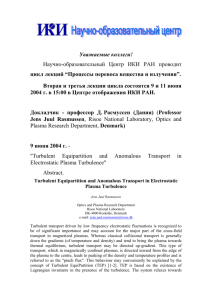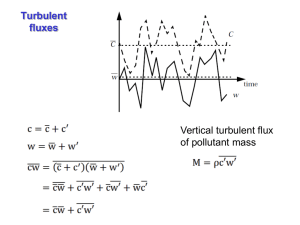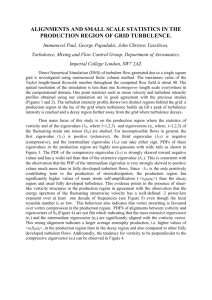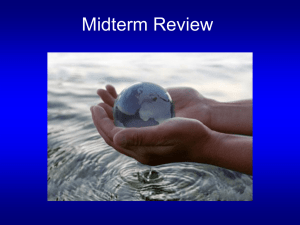Jens Juul Rasmussen
advertisement
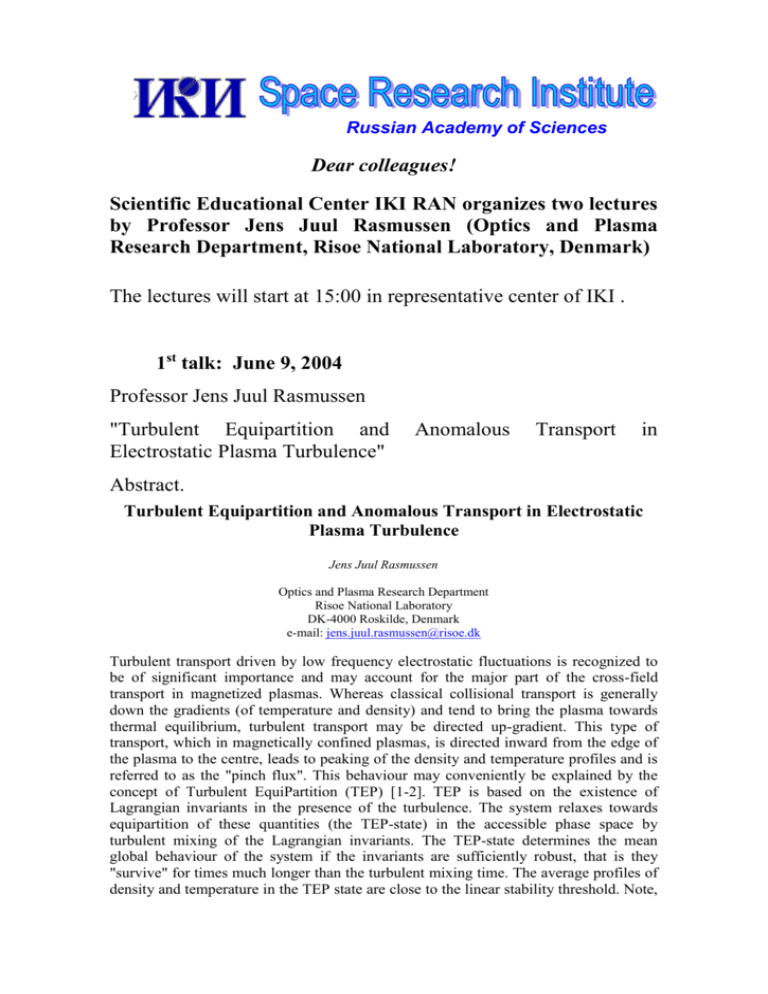
Russian Academy of Sciences Dear colleagues! Scientific Educational Center IKI RAN organizes two lectures by Professor Jens Juul Rasmussen (Optics and Plasma Research Department, Risoe National Laboratory, Denmark) The lectures will start at 15:00 in representative center of IKI . 1st talk: June 9, 2004 Professor Jens Juul Rasmussen "Turbulent Equipartition and Electrostatic Plasma Turbulence" Anomalous Transport in Abstract. Turbulent Equipartition and Anomalous Transport in Electrostatic Plasma Turbulence Jens Juul Rasmussen Optics and Plasma Research Department Risoe National Laboratory DK-4000 Roskilde, Denmark e-mail: jens.juul.rasmussen@risoe.dk Turbulent transport driven by low frequency electrostatic fluctuations is recognized to be of significant importance and may account for the major part of the cross-field transport in magnetized plasmas. Whereas classical collisional transport is generally down the gradients (of temperature and density) and tend to bring the plasma towards thermal equilibrium, turbulent transport may be directed up-gradient. This type of transport, which in magnetically confined plasmas, is directed inward from the edge of the plasma to the centre, leads to peaking of the density and temperature profiles and is referred to as the "pinch flux". This behaviour may conveniently be explained by the concept of Turbulent EquiPartition (TEP) [1-2]. TEP is based on the existence of Lagrangian invariants in the presence of the turbulence. The system relaxes towards equipartition of these quantities (the TEP-state) in the accessible phase space by turbulent mixing of the Lagrangian invariants. The TEP-state determines the mean global behaviour of the system if the invariants are sufficiently robust, that is they "survive" for times much longer than the turbulent mixing time. The average profiles of density and temperature in the TEP state are close to the linear stability threshold. Note, however, that any turbulent mixing will arrange that these marginally stable profiles be reached, even from below and in the absence of sources. In this presentation, I discuss the concept of turbulent equipartition and illustrate it by various examples ranging from large-scale zonal flow generation in rotating fluids to the evolution of pressure driven electrostatic flute modes in a plasma in an inhomogeneous magnetic field. For the case of pressure driven flute mode turbulence [3-5] we have derived a twodimensional model coupling the evolution of density, temperature and potential. The equations are solved numerically on a domain bounded in the direction of the gradient of the magnetic field, and periodic in the other direction. In all the cases investigated the saturated profiles tend to approach the profiles predicted from TEP. Depending on how the system is driven, we observe a clear pinch flux in either density or temperature or both. The pinch flux is connected with the tendency for the system to approach the TEP profiles, which coincide with the marginal stable profiles. The evolution of "poloidal" zonal flows acting as transport barriers and the interplay between the flows and the turbulent flux are also discussed. [1] Yankov, V.V., JETP Lett. 60, 171 (1994). [2] Yankov V.V. and Nycander, J. Phys. Plasmas 4, 2907, (1997) [3] Naulin, V., Nycander J. and Rasmussen, J. Juul, Phys. Rev. Lett. 81, 4148 (1998) [4]Naulin, V., Rasmussen, J. Juul and Nycander, J., Physics of Plasmas 10, 1075-1082, (2003); Erratum: ibid 3804. [5] Garcia, O.E., Naulin, V., Nielsen, A.H., and Rasmussen, J. Juul, Phys. Rev. Lett. 92, 165003, (2004). 2nd talk: June 11, 2004 "Particle diffusion and density flux in low frequency, electrostatic plasma turbulence" Abstract. Particle diffusion and density flux in low frequency, electrostatic plasma turbulence Jens Juul Rasmussen Optics and Plasma Research Department Risoe National Laboratory DK-4000 Roskilde, Denmark e-mail: jens.juul.rasmussen@risoe.dk A characteristic feature of turbulent flows is the ability to disperse and mix particles and heat. This process is very complex even under idealized conditions of homogeneous and isotropic turbulence and is still far from being understood in general. Covering a variety of important areas from the diffusion of pollutants in environmental flows to the particle and heat diffusion in magnetized plasmas in fusion devices this topic connects basic research with applications. In this talk I shall report on our recent investigations on test particle diffusion and transport in anisotropic two-dimensional turbulence [1-3]. We have considered electrostatic drift-wave turbulence in magnetized plasma, described by the so-called Hasegawa-Wakatani equations, which produce a 2D turbulent flow-field with a selfconsistent instability drive. However, our results are also relevant for particle dispersion in geophysical beta-plane turbulence, due to the similarity between drift waves in plasmas and Rossby waves on the beta-plane. In general, we observe that the particle dispersion is strongly anisotropic, with the diffusion in the zonal direction much larger than the diffusion in the direction parallel to the background density gradient – the radial direction (meridional direction for the betaplane analogy). Non-linear couplings lead to the formation of transient coherent vortical structures, and they have a dominating influence on the particle dispersion. We demonstrate, that the trapping of particles in and subsequent displacement with the vortex structures leads to an anomalous diffusion with super diffusive behaviour in the zonal direction and sub diffusive behaviour in the radial direction. Furthermore, we have investigated the turbulent flux originating from the drift wave fluctuations. This flux is intermittent with large bursts and has a strongly non-Gaussian probability distribution function. However, it is still found that that the mean flux is well described by the flux obtained by using the diffusion coefficient obtained from the dispersion of ideal particles and Fick's law. Finally, preliminary investigations of the dispersion of weakly inertial particles will be discussed. Here a tendency for increased super diffusive behaviour is observed [1] Naulin, V., Nielsen, A.H., and Rasmussen, J. Juul, Diffusion of ideal particles in a 2d-model of electrostatic turbulence. Phys. Plasmas (1999) 6, 4575 – 4585. [2] Basu, R Naulin, V., and Rasmussen, J. Juul, Particle dispersion in anisotropic turbulence, Com. Nonlinear Science and Numerical Simulations, (2003), 8, 477- 492. [3] Basu, R , Jessen, T., Naulin, V., and Rasmussen, J. Juul, Turbulent flux and the diffusion of passive tracers in electrostatic turbulence, Physics of Plasmas, (2003), 10, 2696 – 2703. Please call tel: +7(095)3334378, fax: +7(095)3331056 to order your entrance pass. Best regards, Dr. Elena Surovyatkina Space Research Institute Profsoyuznaya 84/32 Moscow 117997 Tel: 7 (095) 333 52 12 ; Fax 7 (095) 913 30 40 iki@cosmos.ru Science Education Center IKI sci-edu@iki.rssi.ru
